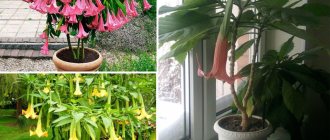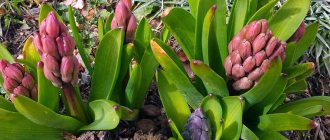Description of the plant
The canna flower belongs to the Cannaceae family and includes several dozen plant species found in the tropical regions of North America, South America, and Asia. A typical species is the Indian eland (Canna indica). In home gardens, mainly numerous, more decorative hybrids are cultivated.
Garden canna (Canna x generalis), known simply as canna, is characterized by ovate-lanceolate leaves mounted on stiff, hollow stems ending in an inflorescence. This is an extremely original perennial plant - grown for its decorative and exotic leaves and bright flowers that decorate the garden from July until the first frost.
The plant produces beautiful, very original flowers that have an asymmetrical structure and form a characteristic panicle inflorescence. Flowers are often very intensely colored:
- red,
- orange,
- pink,
- yellow.
Currently, there are unique varieties with shades of salmon or apricot, and two-tone varieties with contrasting colors are popular. The decorative effect is added by the stamens protruding from the petals.
Cannas can grow up to 2 meters, the height of the plant depends on the variety.
The canna rhizome contains a lot of starch; American tribes ate it baked.
Review of Canna Lucifer
A
Author
rated 09/20/2018
Grade
beautiful, bright flowers, blooms for a long time
No
Kanna Lucifer
Cannas are tropical and subtropical flowering plants with large, banana-like leaves. Cannas are often grown for their foliage only. Large paddle-shaped leaves are found in green, blue-green, variegated and striped. A lot of work has been done to create more attractive and varied colors. Canna flowers come in shades and combinations of yellow, orange, red and pink and appear on tall stems protruding from the foliage.
Cannas are beautiful plants that are grown for their colorful flowers and foliage. They have bright, tropical flowers that will keep you happy all summer long. The large foliage is as colorful as the flowers. The leaves can be green, bronze or burgundy and are often striped or marbled. Cannas belong to the Cannaecae family and have leaves that resemble banana leaves. They are tropical and subtropical perennials that are grown year-round and can reach 10 feet in height in their native habitat. In temperate regions they are cultivated as tender annuals and rarely exceed 4 feet to 6 feet. There are dwarfs that only grow 1 to 2 feet tall.
How to grow cannas
Cannas grow from bulbous structures called rhyosomes. They can be purchased as rhizomes or in pots. They prefer full sun and fertile, well-drained soil, but will adapt to a wide range of different growing conditions. Many of them can be grown even in damp, poorly drained areas and shallow ponds. The flowering of the plant depends on the climate and weather. In areas with cool springs, plants may grow slowly and bloom little.
Landing of Cannes
It is preferable to plant the plant in the spring, after the danger of frost has completely passed. If necessary, large amounts of organic matter, such as compost, will need to be mixed into the soil. Place the rhizomes 3 to 4 inches deep and 1 to 3 feet deep. You can also start sprouting rhizomes in pots indoors in February or March. Transplant them into the garden after the danger of frost has passed. Such plants will produce flowers earlier than those planted from rhizomes that are planted directly into the ground. Cannas grow well and provide their beauty when grown in warm summer temperatures. Keep the soil moist throughout the season. A thick layer of organic mulch helps retain moisture and adds nutrients to the soil. For optimal growth, apply a nitrogen-rich organic fertilizer once a month during the summer. It is necessary to remove flowers that have already drooped to maintain an attractive appearance and allow new beautiful flowers to appear.
Caring for rhizomes
In most countries, Cannas will not survive outdoors during winter periods. To do this, you will need to dig up the rhizomes in the fall. Once the plants have frozen, cut them back 4 to 6 inches from the ground. Then carefully dig up the canna bushes with a shovel or fork. Allow the rhizomes to dry for a few hours and then place them in boxes, wire bins or paper bags. Store canned food in a cool, dry place until next spring. Large rhizomes can be divided in the spring, leaving three to five buds per section. In the warmest parts of the country, the rhizomes may remain in the ground during the winter. It is recommended to divide and replace plants every three to four years to avoid overcrowding. A heavy layer of mulch should be added to protect the rhizomes from freezing.
Comments (0)
Interesting varieties
There are numerous varieties of cannas, differing in size, color of flowers, leaves - large-flowered and less spectacular, small-flowered.
Grouping varieties by color of flowers and leaves
| Color of flowers, leaves | Varieties | Photo |
| With red flowers |
| President |
| With pink flowers |
| Pink Harmony |
| With red-crimson flowers | Crozi Livadia | Livadia |
| With yellow flowers |
| Eureka |
| With orange flowers |
| Orange Beauty |
| With white flowers |
| Ermine |
| Combined, multi-color |
| Canna Cleopatra (photo) |
| with brown-yellow leaves | Durban | Durban |
| green leaves with light stripes | Yellow Bangkok | Yellow Bangkok |
Cannes classification
canna flower
Amazing flowers have several main types and many wonderful varieties.
Main types of cannes
Among the variety of cannas, there are three types of plants that are easy to distinguish by their characteristic features:
- Orchidaceous (orchid) cannas. Spectacular medium-sized bushes up to 2 m high with green leaves. Some varieties have purple foliage. The highlight of these cannas are large flowers up to 17.5 cm in height, which are similar to orchid flowers. They consist of wide petals with wavy edges. These are the flowers of lemon Suevia, yellow with red dots by Richard Wallace, orange with red dots by Andenken an Pfitzer.
- Small-flowered deciduous cannas. Large bushes from 1.5 to 3 m in height bloom with small flowers, no more than 6 cm in height. They have narrow petals, but canna leaves are large, green or purple. These cannas grow mainly in natural conditions; they are rarely planted in the garden. Sometimes you can find the Durban variety with orange leaves with pink-yellow-green stripes.
- Cannes Crozy. Compact bushes with a height of 60 to 160 cm are distinguished by a bluish coating on the leaves. Small, up to 10 cm in height, inflorescences are very similar to gladiolus flowers. The flower petals are bent, like those of the red-crimson Livadia, deep red America, and bright red President varieties.
The Indian canna also forms a fairly large group. Photos of some of its representatives can be seen later in the article. A feature of this type of crop is the ability to reproduce not only vegetatively, but also with the help of seeds. In addition, almost all Indian cannas are late bloomers. They bloom in July or even August, but bloom until October-November (depending on the growing region). But these flowers vary in height. Thus, the dwarf yellow Pak grows no more than 60 cm in height, while the white-flowered Eurika stretches up to 1.5 m.
Different division factors
In the literature you can often find another group of cannas, into which flower growers include all spotted varieties. That’s what they are called – Spotted eland, which in English means “spotted, spotted, speckled.” Cannes are often sold in stores under this name.
Another general classification of cannas depends on the time of flowering and leaf color. According to the timing of flowering, they are divided into early and late varieties.
Based on the color of their leaves, cannas are also grouped into two groups:
- green-leaved cannas with a characteristic green foliage color without additional shades;
- red-leaved varieties - in which the leaves are colored purple-brown.
Now let's look at canna varieties that differ in their flowering period and study their representatives.
Landing site requirements
The rhizome from which the shoots grow is the main supplier of nutrients and planting material, and should produce more baby rhizomes - they will produce flowering plants next season. As the old rhizomes die off and new ones are not formed enough, it may happen that the canna will not bloom next season.
To grow beautiful cannas in open ground, it is important to provide optimal conditions for care and development - only well-watered and fertilized specimens are capable of producing thick rhizomes, from which new plants will grow next year.
The requirements for the position and place of planting canna in the garden are as follows:
- sunny, warm position;
- solitary position;
- fertile, humus, constantly moist soil with a pH of 6.5-7.0;
- A good step is to fertilize the soil with rotted manure or compost before planting in the fall or spring.
Requirements for planting in a pot:
- the pots intended for planting must be large enough to allow the rhizome to grow freely;
- it is necessary to place good drainage in the pot, which will protect the rhizome from rotting;
- The plant needs fertile, humus, permeable soil.
Advice. Cannas growing in pots may fall over, so they should be planted in large, wide-bottomed containers with additional rocks. Cannes in containers should have consistently moist soil.
Deciduous Cannes
The tallest Canna plants reach a height of 3 meters. They have very picturesque leaves of various shades, but the flowers are small, only 6 cm.
The most popular Durban variety is a flower with yellow and orange hues and beautiful leaves that will be a real gem in any garden. Choose a plant to your liking, and numerous photos of Canna on the Internet will help you make the right choice.
Landing
The canna plant requires a very long growing season.
In open ground
To speed up flowering and so that the flower can form thick rhizomes, improving flowering next year, it is worth planting the plants in containers already at the turn of February-March.
The rhizomes are planted in a fertile, humus-rich, permeable substrate, providing warmth in the room (15-18 degrees C).
After the leaves appear, the temperature is increased to 20 degrees Celsius during the day and 12-15 degrees at night; sufficient light must be provided.
Before planting cannas in a permanent place, they should be hardened off. It is important to respect the timing of when to plant cannas. Planting in the ground is carried out after May 15, when there is no danger of frost.
Distances must be maintained:
- 30 × 50 cm – for low grades;
- 60 × 90 cm – for tall ones.
The rhizomes are placed horizontally in the holes, and a layer of earth 5 cm thick is poured over it.
In the pot
From rhizomes that look like in the photo below in March, you can grow a beautifully blooming canna at home.
How to plant cannas in a pot - step by step:
- The rhizome has already developed sprouts and roots, so there will be no problems with rooting.
- To achieve the ideal goal, choose a pot of a size so that the rhizomes fit into it. Fill the pot halfway with peat soil.
- Place the rhizome in the pot and cover it with soil.
- After about 3 weeks, you can start to see how quickly the kana grows.
- This is what the root system looks like 5 weeks after planting.
Attention! Immediately after planting the canna, water should be poured very sparingly so as not to flood the plant. It should be remembered that at the initial stage the rhizome does not have fully developed roots, so it cannot absorb excessive amounts of water and may rot. It is enough to keep the substrate slightly moist.
At this stage of rooting, the plant does not need light. Temperature is important. The higher the temperature, the faster the development. The optimal temperature for rooting canna in a pot is 18-22 ° C.
Canna flower: how to store in winter
digging up canna rhizomes
The plant does not tolerate low winter temperatures and most often dies when exposed to them. In order to preserve the flower, it is dug up immediately after the first frost and prepared for storage. Depending on the existing conditions, choose one of the convenient methods.
Kanna: winter storage in a private home
In a country house, you can preserve the rhizome of the plant by following the following sequence of actions:
- After the plant is dug up, the roots are carefully inspected and left in a ventilated area for several days to dry.
- River sand, which must first be calcined, is best suited for storage.
- The roots covered with sand are transferred to a storage room. The basement is best suited for this purpose.
- The desired temperature for storage is 10 degrees.
- The roots are watered periodically.
- The roots are inspected several times during the winter and any traces of rot are removed.
After digging, the tubers should dry well
Canna: how to preserve a plant in winter in a city apartment
In a city apartment, it is more difficult to create storage conditions, but it is possible:
- You can preserve the roots in a glassed-in loggia. Buried in sand at positive temperatures, they do not lose their ability to germinate.
- Canna lovers leave the roots for storage in the vegetable drawers of the refrigerator. In this case, it is necessary to cover the roots with sand or wood shavings. Inspect it several times in winter and remove any traces of rot.
storing canna roots in a box with sand
The plant is responsive to care, very little effort is needed for the canna flower to grow magnificently in the flowerbed; planting and caring for it is not particularly difficult. Using the recommendations proposed in the article, you can plant a plant every year in the vast expanses of your suburban area or in an apartment and enjoy large, colorful flowers that will delight you with a long flowering period.
Features of cultivation
The plant is unpretentious in cultivation, loves fertile soils and watering, and requires special wintering conditions. To prolong the flowering of canna, faded inflorescences should be removed.
Watering
Growing canna in the garden involves systematic watering. Producing large amounts of greenery requires a constantly moist substrate, so it is important to water mature plants regularly. In too dry soil, plants will not reach a satisfactory size and may not bloom. Water frequently:
- 2-3 times a week in open ground;
- 4-5 times a week when grown in a pot.
Fertilizer feeding
Caring for cannas includes systematic fertilization - every 2 weeks you need to apply fertilizer for flowering plants.
Wintering tubers
Cannes in our climate are not frost-resistant. To enjoy the flower for more than one season, you need to dig up the rhizomes and store them in winter in a place not exposed to frost.
Preparation for wintering and storage of tubers includes the following procedures:
- The tubers are dug up, the above-ground part is cut off at a height of 10-15 cm;
- the rhizomes are slightly torn off the ground, dried and stored in the basement - on shelves or in containers, covered with damp peat;
- during the dormant period, the room where the rhizomes are stored must be maintained at 5-8 degrees C;
- In winter, it is worth inspecting the tubers several times - in case of any damage, infected rhizomes are immediately removed and thrown away.
Cannas tolerate a temporary drop in ambient temperature below 0 degrees C. It is important not to miss the deadline when digging up the canna - the procedure is carried out after the first autumn frosts in two ways:
- When the first frost catches the leaves, cut them off with a sharp knife at a height of 10-15 cm from the ground. Using a large shovel or pitchfork, carefully dig out the root ball.
- First, we dig up the entire plant, then cut off the stem with a sharp knife.
If we have a small number of plants, the second method is more convenient and faster - the truncated rhizomes do not become contaminated. The first method is useful where there is not enough space for a large number of cut leaves.
If it is not possible to maintain the required temperatures, in order to keep the plant tubers in good condition throughout the winter, you need to frequently ventilate the room. To prevent the roots from becoming too dry, it is worth covering them with damp peat or a layer of sawdust.
Growing canna in the garden
The flowers are unpretentious and can be successfully grown in the garden and in public places. Reproduction is carried out by dividing the tubers and by sowing seeds.
Crozy
Sowing canna seeds
Typically, plants were cultivated using this method for breeding purposes. Canna seeds of easily germinating varieties for garden plots appeared quite recently, but quickly gained popularity.
Seeds begin to germinate in late January-early February. The durable shell does not allow the flower to germinate quickly.
To speed up the process, they help it collapse. It is recommended to use one of the methods:
- treated with boiling water;
- keep for 3-4 hours in a thermos with hot water;
- bury it in a snowdrift for 2-3 hours or put it on the freezer shelf for 1 hour;
- act mechanically.
After this treatment, the seeds are placed in an aqueous solution of a growth stimulator for 24 hours. The prepared seeds are placed in bowls with planting soil to a depth of 0.7-1 cm, after watering they are covered with film and removed for germination, which lasts for a month. At this time, conditions are created in the soil so that its temperature remains at +22 ºC. After 3-4 leaves grow, the seedlings are transferred to separate containers. Flowers develop in them before being transplanted outside. After 3-4 days, the picked seedlings are kept in a room with a temperature of +16...+18 ºC.
Growing from rhizomes
Dividing the rhizome is a reliable way to propagate cannas. It begins in the last ten days of March - the first days of April. The roots, stored in the cellar over the winter, are cleaned and the dried parts are separated. Each is cut into sections, focusing on the number of buds on the tuber. Those who are close do not share.
To prevent infection by fungal diseases, the resulting sections are treated with potassium permanganate (0.2 g per 1 liter of water) or wood ash.
The prepared cuttings are planted in the ground, consisting of equal parts of soil, peat chips and rotted manure. You shouldn't go deep. Germination of the first leaves should be expected in 2-3 weeks. As they appear, the pots are moved to well-lit rooms, where they will be at a temperature of +16...+18 ºC. Under the created conditions, new shoots do not stretch and develop in time. Minor watering and keeping the temperature down is all the care young seedlings need.
Reproduction
Cannes are propagated in several ways:
- vegetative - dividing the bush;
- generative - seeds
Reproduction by dividing the underground part
Canna reproduces most easily by dividing the rhizome into smaller fragments with at least 1-2 buds. The plant is propagated in this way in the spring, before planting. The tubers are dug out from the substrate, washed from the soil, the wounds are dried, and sprinkled with charcoal.
Propagation by seeds
When deciding on generative propagation (seed sowing), it should be remembered that the resulting seedlings will not exactly replicate the characteristics of the mother plant.
The seeds should be soaked in warm water for about 24 hours before sowing, then sown in permeable soil, ensuring a temperature of about 21°C.
Photo. Germinating canna seeds
Seeds that have been previously germinated are planted separately in small containers. If you have several seeds, you can plant them directly in pots with a cross section of 7x7 cm, and when the roots outgrow the pot, we transplant them again into pots twice as large - 14x14 cm.
Seedlings need to be cared for throughout the summer to ensure beautiful flowers next year, the size and color of which cannot be completely predicted. If the seeds are sown in early January, there is a high probability of getting flowering plants this year.
This is interesting! The seeds are so heavy that they were previously used as weapons or as beads to make jewelry.
Diseases and pests
Cannas usually do not suffer from serious diseases. Although they can be affected by some diseases:
- viral diseases are signs of damage: plants do not bloom, do not have bright spots on the leaves, various types of deformations are observed;
- fungal (for example, rust);
- bacterial (canna bacteriosis).
The development of viral diseases is facilitated by unfavorable stressful growing and care conditions:
- strong sunlight,
- quick location change,
- high humidity,
- soil is too wet.
The plant can be affected by pests:
- aphids,
- snails and slugs,
- wireworms,
- nematodes.
Slugs are easy to catch in the evening, using beer traps; you can read more in the article on how to get rid of slugs. The presence of pests can be indicated by traces of dried mucus and round eggs in cracks in the ground and secluded places.
Aphids are destroyed with chemicals; a drug called Confidor 200 SL in a 0.04% concentration is suitable, that is: 4 ml per 10 liters of water.
Appearance and origin of canna
The Cannovae family includes about fifty species. Canna is a perennial herbaceous plant, common in America, India and China. The flower came to Europe several centuries ago and gradually won the love of gardeners.
Canna amazes even the most demanding gardeners with its colors and shapes.
The stems of the plant are straight and do not branch. The leaves are glossy, large, oval, oblong, pointed at the ends. Depending on the variety, the color can be green, purple, striped, or even multi-colored. Quite large and brightly colored flowers are arranged in inflorescences - paniculate or racemose.
The bright flowering of cannas is simply impossible not to notice
Why doesn't canna bloom?
The reasons are different, usually it is a violation of planting dates and care features.
- If the plant planted in May was too small and had little time to grow well, then there will be no flowers this year.
- This flower from South America and Mexico needs a long growing season and plenty of warmth. If the summer is cold, flowering may not occur.
- If the rhizomes were planted in a too shady place, this will limit the development of the plants.
Use in landscape design
Usually flowers are planted in numerous groups to show off the maximum beauty of the flower. Cannes look good in various compositions:
- near the pond;
- against the backdrop of a lawn;
- as an element of the discount;
- in a composition in a flowerbed;
- used for planting in pots, containers on terraces, balconies - varieties are planted whose height does not exceed 60 cm;
- the plant is often an element of urban greenery.
Canna is one of the most popular flowering plants in the garden. Its intensely colored flowers are a very interesting element of every flower bed. The unusual shape and bright color make the plants a little exotic. Knowing how to care for cannas, it is easy to achieve beautiful blooming of huge flowers in your garden.
Mr. Summer Resident recommends: canna in the landscape
Cannas are good both in group plantings and planted individually, which is why they are loved by landscape designers. It is good to plant against the background of low-growing plants: marigolds, coleus, cineraria. Combine with kochia, perilla and petunia.
Orchids
When planting with other flowers, provide a central position by placing medium-sized and low flowers around. When planted in groups, they are placed in the form of wide and long ridges.
Summer balconies, loggias and terraces are decorated with flowers, planted in a flowerpot or large tub.











